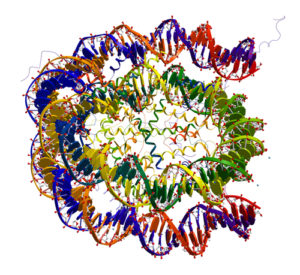 Neurons encounter many different types of DNA errors in three phases of brain development: the rapidly dividing cells building the fetal brain, the differentiation into specific types of neurons and the mature neuron that lasts the life of the organism. The neuron has repair pathways for each of the faults that arise. These mechanisms involve multiple sequenced deliberate steps with large complex interlocking protein machinery and, therefore, it is, not reasonable to consider this self editing and self engineering random. It is not clear how the cell’s self-editing of DNA is directed, which is equivalent to doing surgery on your own brain. The ten step process that is used by lymphocytes to make antibodies and T cell receptors (described in a previous post) is one of the many ways that neurons repair their own DNA.
Neurons encounter many different types of DNA errors in three phases of brain development: the rapidly dividing cells building the fetal brain, the differentiation into specific types of neurons and the mature neuron that lasts the life of the organism. The neuron has repair pathways for each of the faults that arise. These mechanisms involve multiple sequenced deliberate steps with large complex interlocking protein machinery and, therefore, it is, not reasonable to consider this self editing and self engineering random. It is not clear how the cell’s self-editing of DNA is directed, which is equivalent to doing surgery on your own brain. The ten step process that is used by lymphocytes to make antibodies and T cell receptors (described in a previous post) is one of the many ways that neurons repair their own DNA.
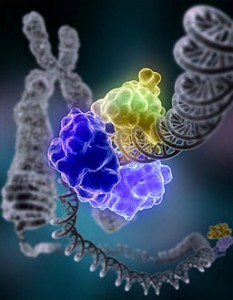 Cellular self editing in a neuron repairs many entirely different types of DNA errors—small changes in a code letter, a piece of RNA stuck in DNA, a small break in a single DNA strand, a large break in a single DNA strand, abnormal crosslinks from chemical reactions, and the most significant error—a break in both strands of DNA.
Cellular self editing in a neuron repairs many entirely different types of DNA errors—small changes in a code letter, a piece of RNA stuck in DNA, a small break in a single DNA strand, a large break in a single DNA strand, abnormal crosslinks from chemical reactions, and the most significant error—a break in both strands of DNA.
For repair, protein machinery identifies the error, pauses cell division, stabilizes the large DNA molecule, cuts out the error, manufactures new pieces of DNA, inserts and sews the new correct code in place, tags the faulty piece and then eliminates it.
Large Number of DNA Errors – Small Number After Repair
When DNA is copied in bacteria, there is one mistake per billion nucleotides copied because of multiple error correcting and repair processes. While high, this error rate is much more accurate than human engineering. Bacterial DNA polymerase activity has one error in 100,000—but after DNA repair, it is 1000 times more efficient. There are several rounds of 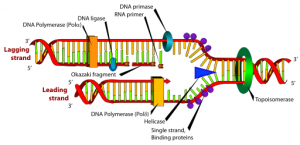 proofreading and repair that increase the accuracy. After a second proofreading, the process is 99% efficient and increases the overall accuracy of replication by another 100 times.
proofreading and repair that increase the accuracy. After a second proofreading, the process is 99% efficient and increases the overall accuracy of replication by another 100 times.
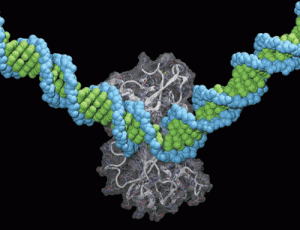 Human neuronal editing is far more complex and more efficient. Human cellular repair is more efficient because it uses many different sensors to detect errors, many different polymerases to copy strands, and many different enzymes to cut and mend mistakes. New repair mechanisms are being discovered frequently; a recent discovery of an error sensor includes two proteins, which surround the DNA strand forming a tunnel between them where the DNA lies. The two proteins then clamp down and find out if the helix changes shape or not.
Human neuronal editing is far more complex and more efficient. Human cellular repair is more efficient because it uses many different sensors to detect errors, many different polymerases to copy strands, and many different enzymes to cut and mend mistakes. New repair mechanisms are being discovered frequently; a recent discovery of an error sensor includes two proteins, which surround the DNA strand forming a tunnel between them where the DNA lies. The two proteins then clamp down and find out if the helix changes shape or not.
 There are many causes of mutations, including damage from cigarettes, car exhaust, ultraviolet light, radiation, viruses, transposons (jumping genes), oxidants and a wide variety of toxic carcinogens.
There are many causes of mutations, including damage from cigarettes, car exhaust, ultraviolet light, radiation, viruses, transposons (jumping genes), oxidants and a wide variety of toxic carcinogens.
Errors occur in all parts of the genetic process. They can occur when histones open up the very tightly bound strands of DNA. Others occur during the polymerase copying of both DNA strands. Copying is confounded by the fact that the code of the two strands are in opposite directions and the copying goes in the same direction on both. The strand that is copied backwards is then edited by breaking it into many different pieces, and splicing them together—another source of errors.
Self-Editing for Antibodies and T cell Receptors
Previous posts discussed the very unusual process of directed DNA cellular self-editing in both the B and T immune cells, called V(D)J. This complex mechanism is, also, used by neurons for correction of one type of DNA error. V(D)J has ten steps–double stranded DNA is cut at many specific points and then the pieces are sewn together randomly in large numbers to generate unique new pieces of DNA code. This code is so varied that it can match most antigens from invading microbes.
The non random V(D)J pathway used by neurons and lymphocytes has the following ten steps:
- Recognition of a particular sequence – proteins bind and catalyze joint
- Breaking one strand of the DNA at that exact point with a nick
- Bending of the regions in hairpin turns and signal ends
- Ligation of the signal ends
- Hairpins are opened in three different ways
- Overhang extension and cleavage of hairpin
- Ligation of other segments
- Enzyme trimming of joints with loss of coding
- Addition of a code element
- Repair of chain
Phases of Brain Development
There are different repair processes necessary for the different stages in the development of the brain — cells that are rapidly dividing and mature neurons that are not dividing. During cell division errors occur in every part of the process. Mature neurons, which last the entire life of the brain, have errors from utilizing a high level of metabolism, which produce oxidative 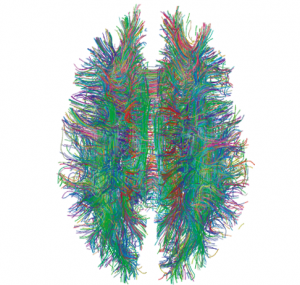 reactive chemical toxins.
reactive chemical toxins.
DNA repair is also necessary for the glial cells that develop at the same time. As previous posts have described, the creation and function of the glial cells are critical for brain function—astrocytes for creation, metabolic support and maintenance and microglia for stimulation of neurons and pruning.
Different repair mechanisms are necessary for different types of damage—single and double strand breaks in DNA and crosslinks in the DNA.The double strand break is the most serious and can cause the most problems. If not repaired these lesions can lead to brain diseases and cancer.
Early Fetal Development – Neurogenesis – Many New Brain Cells
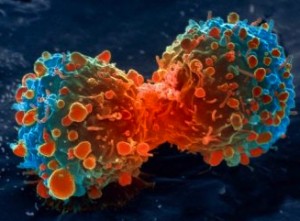 The fetal brain rapidly makes billions of neurons with many errors in the process. In the last month of pregnancy 250,000 neurons appear and integrate into the brain structure every second.
The fetal brain rapidly makes billions of neurons with many errors in the process. In the last month of pregnancy 250,000 neurons appear and integrate into the brain structure every second.
Early stem cells are extremely sensitive to damage. Because damage in a very early cell could have devastating effects in whole regions of the brain, these cells often use apoptosis, or cell death, as a way to deal with serious errors. Later in fetal brain development, they are more likely to use repair instead. For rapid division, special proteins interact with histones and keep the DNA open accessible for copying. For repair to work in this situation, it must interact with the chromatin structure.
Differentiating Cells
After the rapid increase of neurons to a trillion cells, they differentiate into specialized types of neurons for all the different brain structures.When cells are not rapidly dividing, but are in the process of changing to become a very specific type of brain cell, double stranded breaks occur for a variety of different reasons, including metabolic oxidative damage. In this situation both single and double strand breaks frequently occur, requiring several different techniques.
Mature Brain Cells
In mature cells, with no cell division for many years, strands break because of oxidative stress, the creation of inter strand crosslinks by mistaken chemical reactions and problems with transcription to RNA.
The mature brain uses 20% of the oxygen in the body. This produces high metabolic demand and more stress and errors from the oxidative machinery. Mature cells don’t usually use apoptosis.
The mature neuron has up to 1,000 single stranded DNA breaks per day. Double stranded breaks, also, occur during transcription—mostly in promoter regions, which are related to DNA repair machinery itself. In the hippocampus, neurogenesis continues in adulthood at the rate of 700 neurons per day; these neurons have the same damage as other dividing cells.
DNA Repair Pathways
There are many DNA repair pathways—the major being NER, BER, NHEJ, HR, and MMR. Single stranded breaks are more frequent. They can lead to neurodegenerative brain disease. Double strand breaks are more serious and can lead to cancer and many other brain diseases.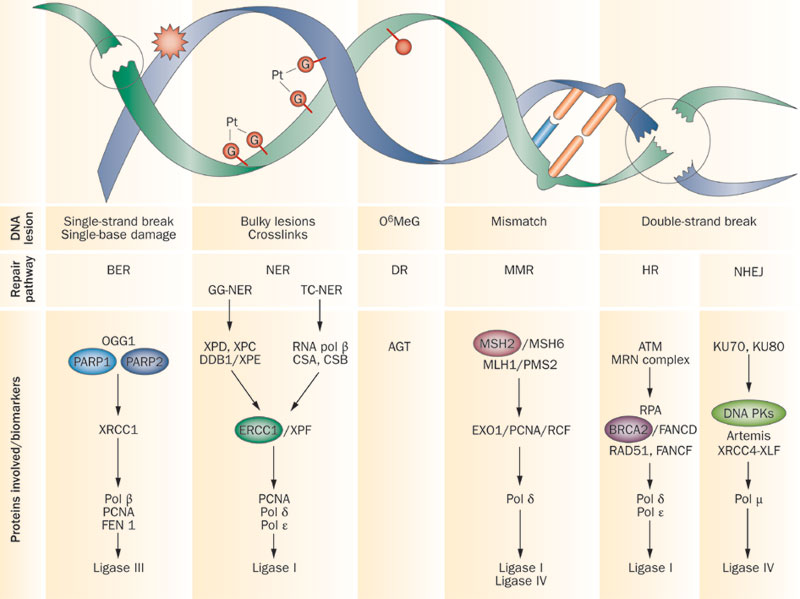
Single Strand DNA Break Repair
NER – nucleotide excision pathway – NER is one of the three pathways to repair 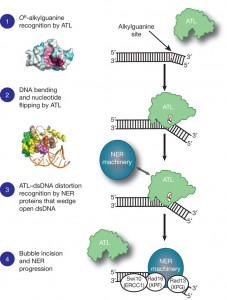 single strand breaks in DNA caused by oxidative damage, chemicals, ultraviolet radiation and mutagens. It is the process that repairs large bulky lesions that alter the structure of the two stranded helix.
single strand breaks in DNA caused by oxidative damage, chemicals, ultraviolet radiation and mutagens. It is the process that repairs large bulky lesions that alter the structure of the two stranded helix.
Ultraviolet light results in very specific damage causing parts of DNA to inappropriately bond to other molecules. The piece of DNA that is damaged is cut. The large enzyme, DNA polymerase, that ordinarily copies DNA, makes another copy of this segment from the good second strand. Then the enzyme DNA ligase sews the good piece into the defective cut strand. There are two distinct ways that the damage is identified, but use the same cut, new copy, and pasting.
BER – base excision repair– BER is the second process for single stranded DNA 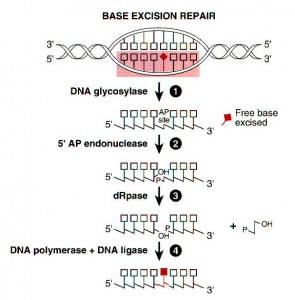 repair. It recognizes very specific smaller lesions, which are eliminated by specific enzymes called glycosylases.
repair. It recognizes very specific smaller lesions, which are eliminated by specific enzymes called glycosylases.
The base excision repair process operates throughout the entire cell cycle, not just when a broken strand and good strand are both available. It removes small base lesions that don’t totally alter the basic helix structure. This process is critical for single bases that have been altered in one way or another through chemicals or other mutations. These mutations would cause mis-pairing of bases and future breaks in copying. A special enzyme AP endonuclease cuts out the base or multiple bases causing a single strand break. Then, either a correct base or a stringer of 2 to 10 bases are produced and sewn into place.
MMR – Mismatch Bases Repair – Mismatch repair is the third process for single stranded DNA errors and it only corrects specific mismatched base pairs.
Double Stranded DNA Break Repair
NHEJ – non homologous end joining – The most complex and important repair 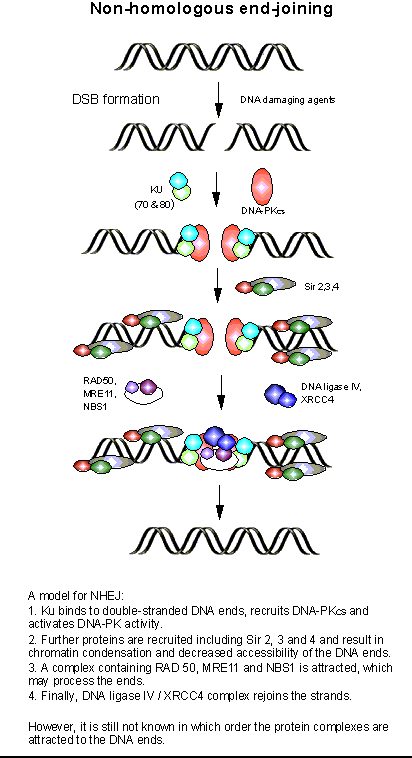 process for double stranded DNA breaks is called non homologous end joining, or NHEJ and was described above as the critical part of the process making antibodies and T cell receptors.
process for double stranded DNA breaks is called non homologous end joining, or NHEJ and was described above as the critical part of the process making antibodies and T cell receptors.
It is called non homologous because the broken ends are sewn together without reference to a second, similar – homologous, piece of DNA. This process is unique in that it doesn’t need an accurate template for the repair (as does HR – homologous repair).
The process uses overhangs of the broken DNA as small homologous pieces to guide the repair. There is another similar pathway that is less accurate called microhomology-mediate end joining (MMEJ). The ends show short similar sections that are aligned for repair. But, this deletes the DNA between the small microhomologies, or similar strands.
The first step in NHEJ is recognition of the DNA break and building a large complex, called the NHEJ complex, at the point of the double break. The second step involves creating a bridge between the two pieces of DNA to stabilize the structure. Next is processing of the ends of the DNA piece. After that is sewing the broken DNA back together. The last step dissolves the NHEJ complex.
HR- Homologous recombination also repairs DNA double stranded breaks. This 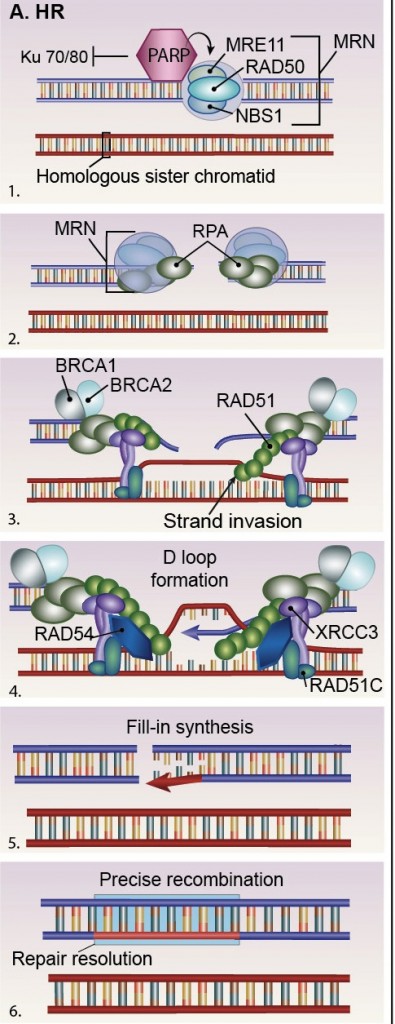 requires a sister DNA strand that is not abnormal to help in the repair—a homologous pair. Because HR depends upon having a correct strand to reference in the repair, it only occurs when copying is occurring.
requires a sister DNA strand that is not abnormal to help in the repair—a homologous pair. Because HR depends upon having a correct strand to reference in the repair, it only occurs when copying is occurring.
Homologous recombination is both a natural part of the cellular division process and a technique for repair of double stranded breaks in DNA. It is an inherent part of human cell division where new combinations are created to foster more diversity during meosis– the cell division that makes sperm and egg cells. It is also used widely in nature in horizontal gene transfer, where bacteria and viruses cut out and transfer pieces of DNA between themselves or into animal and plant cells. It appears to be a universal process in virus, bacteria and human cells, which use nearly identical enzymes.
After a double-stranded DNA break is found, enzymes cut sections of the DNA at the 5’ ends (resection). Then an end (3’) of the broken DNA connects with another strand of DNA (strand invasion). Then cross structures bind the two DNA molecules. Enzymes restoring the original piece of DNA, then, cut the pieces.
The Many Ways Neurons Repair Their Own DNA
There are many self directed overlapping editing processes in the neuron. It is not at all clear how these complex self editing processes are directed. Alternative RNA splicing takes a messenger RNA that was once thought to represent one gene and then cuts it in multiple places, mixes the pieces, and sews them together in many different ways. This process can make 500 different proteins out of what was considered one gene.
The same ten step DNA editing process that makes millions of antibodies is used by the neuron for its own DNA self editing.
The neuron is presented with a score of distinctly different DNA error problems such as mistaken letters, chemical interactions with toxins that alter the DNA shape, various broken single strands, and the most dangerous, broken double stranded DNA. After sensing the error, all of these different faults are approached with different techniques. Repair pathways involve many steps using very large complex machinery that perform deliberate error sensing; pausing cell division; DNA cutting; strand bending; new strand copying; transporting, inserting and sewing of the new corrected DNA strands; tagging and eliminating faulty DNA; and eliminating repair machinery.
How can anyone consider this cellular self-editing as a random process? How can anyone not consider this intelligent cellular behavior?
